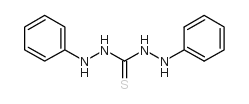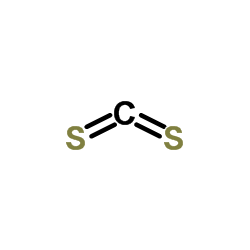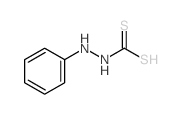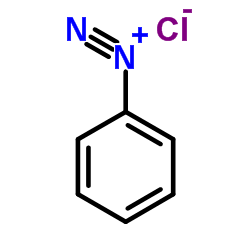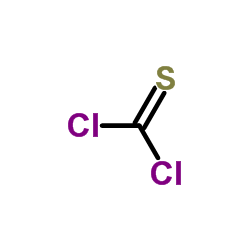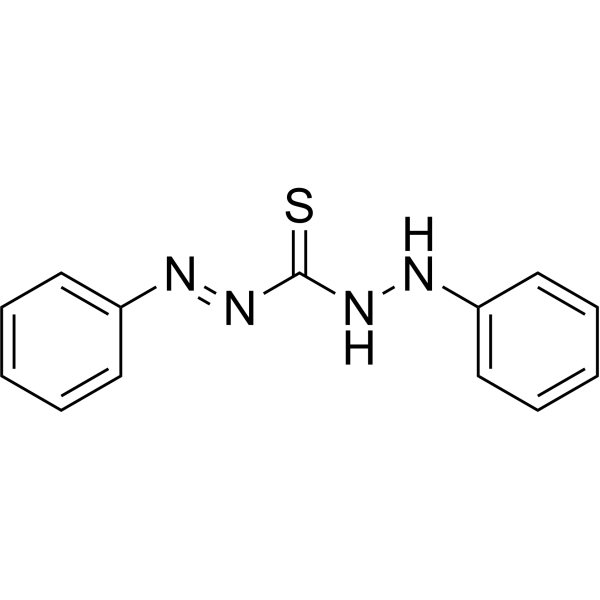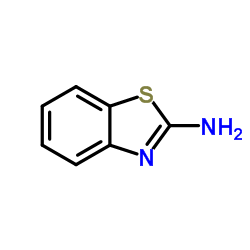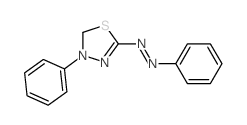622-03-7
| 中文名 | 二苯基硫代卡巴肼 |
|---|---|
| 英文名 | Diphenylthiocarbazide |
| 中文别名 |
二苯氨基硫脲
二苯基硫代羰二肼 二苯胺基代硫脲 二苯氨基代硫脲 二苯基硫卡巴肼 |
| 英文别名 |
EINECS 210-717-2
1,3-dianilinothiourea MFCD00046042 |
| 密度 | 1.322g/cm3 |
|---|---|
| 沸点 | 383.9ºC at 760 mmHg |
| 熔点 | 155°C |
| 分子式 | C13H14N4S |
| 分子量 | 258.34200 |
| 闪点 | 186ºC |
| 精确质量 | 258.09400 |
| PSA | 80.21000 |
| LogP | 3.43250 |
| 外观性状 | 固体;White to Gray to Brown powder to crystal |
| 折射率 | 1.749 |
| 储存条件 | 0-10°C;存放于惰性气体之中;避免光,空气,加热 |
| 水溶解性 | 微溶:乙醇 |
| 分子结构 | 1、 摩尔折射率:79.52 2、 摩尔体积(cm3/mol):195.3 3、 等张比容(90.2K):562.8 4、 表面张力(dyne/cm):68.9 5、 极化率(10-24cm3):31.52 |
| 计算化学 | 1.疏水参数计算参考值(XlogP):3.7 2.氢键供体数量:4 3.氢键受体数量:3 4.可旋转化学键数量:4 5.互变异构体数量:2 6.拓扑分子极性表面积80.2 7.重原子数量:18 8.表面电荷:0 9.复杂度:223 10.同位素原子数量:0 11.确定原子立构中心数量:0 12.不确定原子立构中心数量:0 13.确定化学键立构中心数量:0 14.不确定化学键立构中心数量:0 15.共价键单元数量:1 |
| 更多 | 1. 性状:暗红色结晶性粉末。 2. 密度(g/mL,25/4℃):未确定 3. 相对蒸汽密度(g/mL,空气=1):未确定 4. 熔点(ºC):156-158 5. 沸点(ºC,常压):未确定 6. 沸点(ºC,5.2kPa):未确定 7. 折射率:未确定 8. 闪点(ºC):未确定 9. 比旋光度(º):未确定 10. 自燃点或引燃温度(ºC):未确定 11. 蒸气压(kPa,25ºC):未确定 12. 饱和蒸气压(kPa,60ºC):未确定 13. 燃烧热(KJ/mol):未确定 14. 临界温度(ºC):未确定 15. 临界压力(KPa):未确定 16. 油水(辛醇/水)分配系数的对数值:未确定 17. 爆炸上限(%,V/V):未确定 18. 爆炸下限(%,V/V):未确定 19. 溶解性:溶于碱而分解,微溶于冷乙醇和苯。 |
|
Section I.Chemical Product and Company Identification Chemical Name Diphenylthiocarbazide Portland OR SynonymCarbonothioic Dihydrazide, 2,2'-diphenyl- (9 CI) Chemical FormulaC6H5NHNHCSNHNHC6H5 CAS Number622-03-7 Section II.Composition and Information on Ingredients Chemical NameCAS Number Percent (%)TLV/PELToxicology Data Diphenylthiocarbazide622-03-7---------- Not available.Rat LD50 (oral) 1500mg/kg Mouse LD50 (intraperitoneal) 200mg/kg Section III. Hazards Identification Acute Health EffectsHarmful if ingested or inhaled. Minimize exposure to this material. Severe overexposure can result in injury or death. Irritating to eyes and skin on contact. Inhalation causes irritation of the lungs and respiratory system. Inflammation of the eye is characterized by redness, watering, and itching. Skin inflammation is characterized by itching, scaling, reddening, or, occasionally, blistering. Follow safe industrial hygiene practices and always wear proper protective equipment when handling this compound. CARCINOGENIC EFFECTS : Not available. Chronic Health Effects MUTAGENIC EFFECTS : Not available. TERATOGENIC EFFECTS : Not available. DEVELOPMENTAL TOXICITY: Not available. Repeated or prolonged exposure to this compound is not known to aggravate existing medical conditions. Section IV.First Aid Measures Eye ContactCheck for and remove any contact lenses. In case of contact, immediately flush eyes with plenty of water for at least 15 minutes. Get medical attention. Skin ContactIn case of contact, immediately flush skin with plenty of water. Remove contaminated clothing and shoes. Wash clothing before reuse. Thoroughly clean shoes before reuse. Get medical attention. InhalationIf the victim is not breathing, perform mouth-to-mouth resuscitation. Loosen tight clothing such as a collar, tie, belt or waistband. If breathing is difficult, oxygen can be administered. Seek medical attention if respiration problems do not improve. IngestionINDUCE VOMITING by sticking finger in throat. Lower the head so that the vomit will not reenter the mouth and throat. Loosen tight clothing such as a collar, tie, belt or waistband. If the victim is not breathing, perform mouth-to-mouth resuscitation. Examine the lips and mouth to ascertain whether the tissues are damaged, a possible indication that the toxic material was ingested; the absence of such signs, however, is not conclusive. Section V.Fire and Explosion Data Auto-IgnitionNot available. FlammabilityMay be combustible at high temperature. Flash PointsFlammable LimitsNot available. Not available. Combustion ProductsThese products are toxic carbon oxides (CO, CO 2), nitrogen oxides (NO, NO2), sulfur oxides (SO2, SO3...). Fire Hazards Not available. Risks of explosion of the product in presence of mechanical impact: Not available. Explosion Hazards Risks of explosion of the product in presence of static discharge: Not available. Fire Fighting Media SMALL FIRE: Use DRY chemical powder. and InstructionsLARGE FIRE: Use water spray, fog or foam. DO NOT use water jet. Consult with local fire authorities before attempting large scale fire-fighting operations. Continued on Next Page Diphenylthiocarbazide Section VI.Accidental Release Measures Spill CleanupHarmful material. Irritating material. InstructionsUse a shovel to put the material into a convenient waste disposal container. Finish cleaning the spill by rinsing any contaminated surfaces with copious amounts of water. Consult federal, state, and/or local authorities for assistance on disposal. Section VII. Handling and Storage Handling and StorageHARMFUL. IRRITANT. Keep away from heat. Mechanical exhaust required. When not in use, tightly seal the container and store in a dry, cool place. Avoid excessive heat and light. Do not breathe dust. Information Always store away from incompatible compounds such as oxidizing agents. Section VIII. Exposure Controls/Personal Protection Engineering ControlsUse process enclosures, local exhaust ventilation, or other engineering controls to keep airborne levels below recommended exposure limits. If user operations generate dust, fume or mist, use ventilation to keep exposure to airborne contaminants below the exposure limit. Personal ProtectionSplash goggles. Lab coat. Dust respirator. Boots. Gloves. Suggested protective clothing might not be sufficient; consult a specialist BEFORE handling this product. Be sure to use a MSHA/NIOSH approved respirator or equivalent. Exposure LimitsNot available. Section IX. Physical and Chemical Properties Solubility Physical state @ 20°CSolid. (White crystalline powder.)Not available. Not available. Specific Gravity Molecular Weight258.34Partition CoefficientNot available. Boiling PointNot available.Vapor PressureNot applicable. Melting Point155°C (311°F)Vapor DensityNot available. Not available.VolatilityNot available. Refractive Index Critical TemperatureOdorNot available. Not available. Not available.Not available. ViscosityTaste Section X.Stability and Reactivity Data This material is stable if stored under proper conditions. (See Section VII for instructions) Stability Conditions of Instability Avoid excessive heat and light. Incompatibilities Reactive with oxidizing agents. Section XI. Toxicological Information RTECS NumberFF2800000 Routes of ExposureEye Contact. Ingestion. Inhalation. Rat LD50 (oral) 1500mg/kg Toxicity Data Mouse LD50 (intraperitoneal) 200mg/kg Chronic Toxic EffectsCARCINOGENIC EFFECTS : Not available. MUTAGENIC EFFECTS : Not available. TERATOGENIC EFFECTS : Not available. DEVELOPMENTAL TOXICITY: Not available. Repeated or prolonged exposure to this compound is not known to aggravate existing medical conditions. Acute Toxic EffectsHarmful if ingested or inhaled. Minimize exposure to this material. Severe overexposure can result in injury or death. Irritating to eyes and skin on contact. Inhalation causes irritation of the lungs and respiratory system. Inflammation of the eye is characterized by redness, watering, and itching. Skin inflammation is characterized by itching, scaling, reddening, or, occasionally, blistering. Follow safe industrial hygiene practices and always wear proper protective equipment when handling this compound. Continued on Next Page Diphenylthiocarbazide Section XII.Ecological Information EcotoxicityNot available. Environmental FateNot available. Section XIII. Disposal Considerations Recycle to process, if possible. Consult your local regional authorities. You may be able to dissolve or mix material with a Waste Disposal combustible solvent and burn in a chemical incinerator equipped with an afterburner and scrubber system. Observe all federal, state and local regulations when disposing of the substance. Section XIV. Transport Information DOT ClassificationNot a DOT controlled material (United States). PIN NumberNot applicable. Proper Shipping Name Not applicable. Packing Group (PG)Not applicable. DOT Pictograms Section XV. Other Regulatory Information and Pictograms TSCA Chemical InventoryThis compound is ON the EPA Toxic Substances Control Act (TSCA) inventory list. (EPA) WHMIS Classification On NDSL. (Canada) EINECS Number (EEC) 210-717-2 EEC Risk StatementsR20/21/22- Harmful by inhalation, in contact with skin and if swallowed. R36/37/38- Irritating to eyes, respiratory system and skin. Japanese Regulatory Data SECTION 16 - ADDITIONAL INFORMATION N/A |
| 风险声明 (欧洲) | 22-36/37/38 |
|---|---|
| 安全声明 (欧洲) | S22-S36/37/39 |
| RTECS号 | FF2800000 |
| 海关编码 | 2930909090 |
| 上游产品 8 | |
|---|---|
| 下游产品 5 | |
| 海关编码 | 2930909090 |
|---|---|
| 中文概述 | 2930909090. 其他有机硫化合物. 增值税率:17.0%. 退税率:13.0%. 监管条件:无. 最惠国关税:6.5%. 普通关税:30.0% |
| 申报要素 | 品名, 成分含量, 用途 |
| Summary | 2930909090. other organo-sulphur compounds. VAT:17.0%. Tax rebate rate:13.0%. . MFN tariff:6.5%. General tariff:30.0% |


